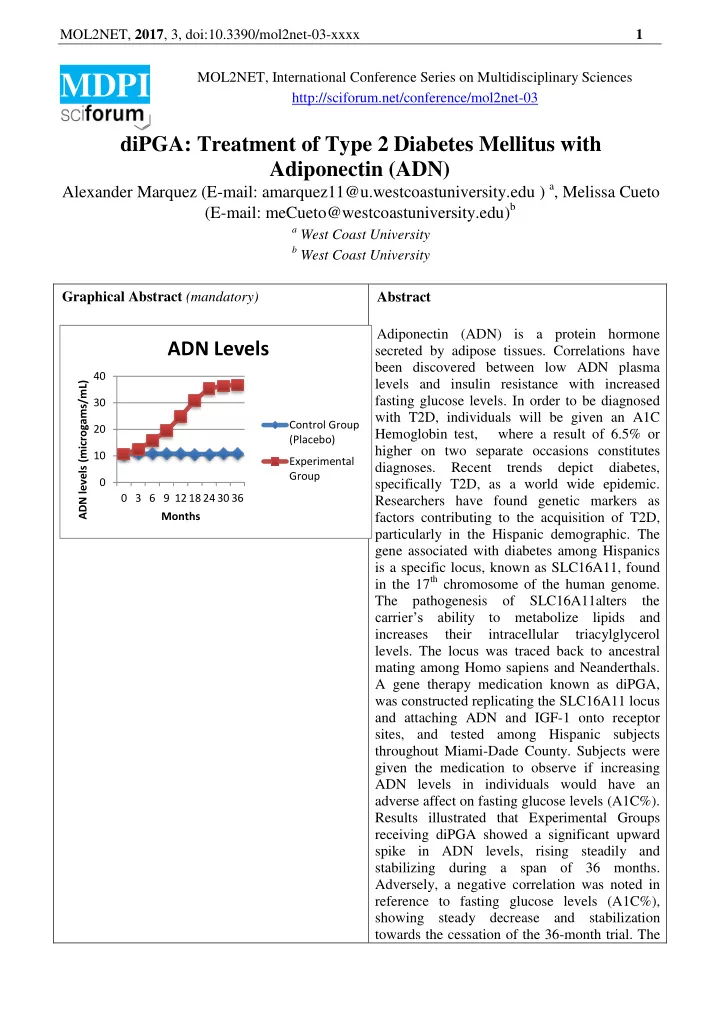

MOL2NET, 2017 , 3, doi:10.3390/mol2net-03-xxxx 1 MOL2NET, International Conference Series on Multidisciplinary Sciences MDPI http://sciforum.net/conference/mol2net-03 diPGA: Treatment of Type 2 Diabetes Mellitus with Adiponectin (ADN) Alexander Marquez (E-mail: amarquez11@u.westcoastuniversity.edu ) a , Melissa Cueto (E-mail: meCueto@westcoastuniversity.edu) b a West Coast University b West Coast University Graphical Abstract (mandatory) Abstract Adiponectin (ADN) is a protein hormone ADN Levels secreted by adipose tissues. Correlations have been discovered between low ADN plasma 40 ADN levels (microgams/mL) levels and insulin resistance with increased fasting glucose levels. In order to be diagnosed 30 with T2D, individuals will be given an A1C Control Group 20 Hemoglobin test, where a result of 6.5% or (Placebo) higher on two separate occasions constitutes 10 Experimental diagnoses. Recent trends depict diabetes, Group 0 specifically T2D, as a world wide epidemic. 0 3 6 9 12 18 24 30 36 Researchers have found genetic markers as Months factors contributing to the acquisition of T2D, particularly in the Hispanic demographic. The gene associated with diabetes among Hispanics is a specific locus, known as SLC16A11, found in the 17 th chromosome of the human genome. The pathogenesis of SLC16A11alters the carrier’s ability t o metabolize lipids and increases their intracellular triacylglycerol levels. The locus was traced back to ancestral mating among Homo sapiens and Neanderthals. A gene therapy medication known as diPGA, was constructed replicating the SLC16A11 locus and attaching ADN and IGF-1 onto receptor sites, and tested among Hispanic subjects throughout Miami-Dade County. Subjects were given the medication to observe if increasing ADN levels in individuals would have an adverse affect on fasting glucose levels (A1C%). Results illustrated that Experimental Groups receiving diPGA showed a significant upward spike in ADN levels, rising steadily and stabilizing during a span of 36 months. Adversely, a negative correlation was noted in reference to fasting glucose levels (A1C%), showing steady decrease and stabilization towards the cessation of the 36-month trial. The
MOL2NET, 2017 , 3, doi:10.3390/mol2net-03-xxxx 2 results of this clinical trial raise implications that can positively impact the scientific, medical, and Hispanic communities worldwide if successfully replicated in future studies. Note: This paper was an assignment for a nursing school General Education Capstone course. The student writer did not conduct a real study; he rather simulated a study to demonstrate writing/research skills, creativity, scientific knowledge, and an understanding of how to generate and analyze data. The corresponding author is the student’s instructor, who guided the student on each section of the scientific paper, providing feedback on how to “conduct” the study and on how to revise the writing. Introduction Literature Review Type 2 Diabetes (T2D), has become a disease epidemic. As stated in 2015 by the American Diabetes Association (2017), approximately 30 million Americans have been diagnosed with diabetes and there are approximately 1.5 million new cases of diabetes each year. Diabetes is the seventh leading cause of death in the United States, killing approximately 80,000 Americans annually as of 2015, and it costs Americans an excess of $240 billion annually (American Diabetes Association, 2017). There are two types of diabetes that affect the majority of the population, and can often be confused: Type 1 and Type 2 diabetes. The Diabetes Teaching Center (n.d) at the University of California, San Francisco defines Type 2 Diabetes as a dually defective disease in which the body has resistance to insulin in combination with the inability of insulin production. T2D is the most common form of diabetes, making up 80 – 90% of the diabetic population (Diabetes Teaching Center at UCSF, n.d). In reference to pathogenesis, Copstead and Banasik (2013) characterize T2D by a relative systemic lack of insulin. The body’s tissues become hyperglycemic due to insulin resistance, increasing the amount of excess glucose in the bloodstream (Copstead & Banasik, 2013). This resistance causes tissues to biologically need more insulin than normally required to consume glucose and remain homeostatic (Copstead & Banasik, 2013). Both the liver and gastrointestinal tract are responsible for releasing glucose into the blood stream so it can systemically spread throughout the body (Copstead & Banasik, 2013). In particular, the liver is responsible for gluconeogenesis, which converts consumed sugar from foods and synthesizes it into glucose for the body to use as energy (Copstead & Banasik, 2013). Thereafter, the body, specifically the pancreas (organ responsible for insulin production) begins to compensate for the insulin resistance by creating larger quantities of insulin, hyperinsulimia; decomposition begins to occur when the Beta cells in the pancreas become dysfunctional which causes the pancreas to not produce enough insulin to metabolize the body’s glucose levels and overcome the insulin resistance (Copstead & Banasik, 2013). The insulin deficiency over a period of time leads to the acquisition of diabetes and glucose toxicity, thus granting the need of some sort of exogenous diabetic treatment (Copstead & Banasik, 2013). The correlation between Type 2 diabetes and dietary/lifestyle habits are well known, especially in association with high caloric Westernized eating habits consisting of high consumptions of red and/or processed meats, dairy products, high-sugar products, eggs, and refined grains (Zhao et al., 2017). Additionally, these Westernized eating habits increase risk factors such as Body Mass Index
Recommend
More recommend